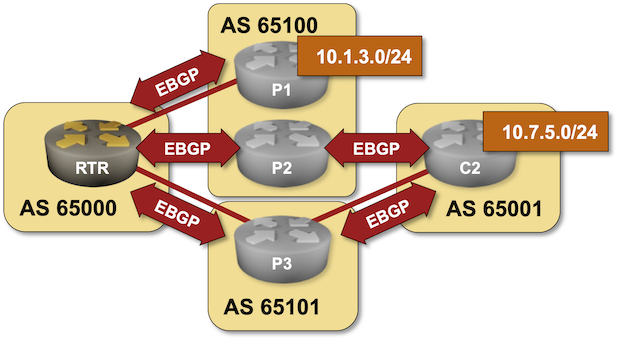EVPN Rerouting After LAG Member Failures
In the previous two blog posts (Dealing with LAG Member Failures, LAG Member Failures in VXLAN Fabrics) we discovered that it’s almost trivial to deal with a LAG member failure in an MLAG cluster if we have a peer link between MLAG members. What about the holy grail of EVPN pundits: ESI-based MLAG with no peer link between MLAG members?
EVPN Rerouting After LAG Member Failures
In the previous two blog posts (Dealing with LAG Member Failures, LAG Member Failures in VXLAN Fabrics) we discovered that it’s almost trivial to deal with a LAG member failure in an MLAG cluster if we have a peer link between MLAG members. What about the holy grail of EVPN pundits: ESI-based MLAG with no peer link between MLAG members?
Cisco vPC in VXLAN/EVPN Network – Part 6 – vPC Enhancements
There are a lot of options when it comes to vPC. What enhancements should you consider? I’ll go through some of the options worth considering.
Peer Switch – The Peer Switch feature changes how vPC behaves in regards to STP. Without this enabled, you would configure different STP priorities on the primary and secondary switch. The secondary switch forwards BPDUs coming from vPC-connected switches towards the primary switch. The secondary switch doesn’t process these received BPDUs. Only the primary switch sends BPDUs to the vPC-connected switches. Note that the secondary switch can process and send BPDUs to switches that are only connected to the secondary switch. Without Peer Switch it looks like this:

- The BPDU sent by SW04 is not processed by SW02. It is forwarded towards SW01.
- SW04 BPDU is only sent initially. Port will become Root port and stop sending BPDUs.
- SW02 sends BPDU towards SW05 as it is not connected with vPC. The BPDU has information about cost to Root (SW01).
- SW02 doesn’t send BPDU towards SW03 as it is connected with vPC.
- SW01 and SW02 have different STP priorities and send distinct BPDUs. They are not one switch from STP perspective.
- If SW01 goes down, STP Continue reading
PP015: Zero Trust Architecture: Because You Can’t Trust Anybody Any More
Zero trust is a buzzword, but what does it actually mean and how will it impact network engineers? Jennifer is here to get us up to speed. First, she gives a general description: It’s a security architectural strategy that’s progressing toward increased observability and trust inferences. Then she breaks it down for the three main... Read more »What’s new in Calico – Spring 2024
Calico, the leading solution for container networking and security, unveils a host of new features this spring. From new security capabilities that simplify operations, enhanced visualization for faster troubleshooting, and major enhancements to its popular workload-centric distributed WAF, Calico is set to redefine how you manage and secure your containerized workloads.
This blog describes the new capabilities in Calico.
Simplified security operations for Runtime Threat Detection
Runtime threat detection generates a large number of security events. However, managing and analyzing these events can be challenging, and users need a way to summarize and navigate through them to gain deeper insights and take appropriate actions. Let’s see how Calico simplifies runtime security operations.
New Security Events Dashboard
We are excited to announce the introduction of the Security Event Dashboard in Calico. This dashboard provides a summary of the security events generated by the runtime threat detection engine. With the Security Event Dashboard, users can easily analyze and pivot around the data, enabling them to:
- Efficiently find and analyze specific segments of security events.
- Collaborate with stakeholders involved in the analysis, response, and remediation of security events.
The Security Event Dashboard offers a visually appealing and user-friendly interface, presenting key summarizations of Continue reading
Butchering AI

I once heard a quote that said, “The hardest part of being a butcher is knowing where to cut.” If you’ve ever eaten a cut of meat you know that the difference between a tender steak and a piece of meat that needs hours of tenderizing is just inches apart. Butchers train for years to be able to make the right cuts in the right pieces of meat with speed and precision. There’s even an excellent Medium article about the dying art of butchering.
One thing that struck me in that article is how the art of butchering relates to AI. Yes, I know it’s a bit corny and not an easy segue into a technical topic but that transition is about as subtle as the way AI has come crashing through the door to take over every facet of our lives. It used to be that AI was some sci-fi term we used to describe intelligence emerging in computer systems. Now, AI is optimizing my PC searches and helping with image editing and creation. It’s easy, right?
Except some of those things that AI promises to excel at doing are things that professionals have spent years honing their Continue reading
HS072: Making Distributed Work Successful
Don’t call it remote work. Today Johna and Greg dive into distributed work– the future where there is no office vs. remote, there are just asynchronistic workers and their computer screens. Leaders have to move beyond “management by walking around” or “onboarding by shadowing.” They need to carefully select their ecosystem of tools (and tools... Read more »BGP Labs: Load Balancing across EBGP Paths
Let’s open another juicy can of BGP worms: load balancing. In the first lab exercise, you’ll configure equal-cost load balancing across EBGP paths and tweak the “What is equal cost?” algorithm to consider just the AS path length, not the contents of the AS path.

BGP Labs: Load Balancing across EBGP Paths
Let’s open another juicy can of BGP worms: load balancing. In the first lab exercise, you’ll configure equal-cost load balancing across EBGP paths and tweak the “What is equal cost?” algorithm to consider just the AS path length, not the contents of the AS path.

Cisco vPC in VXLAN/EVPN Network – Part 5 – Potential Pitfalls
Like I hinted at in an earlier post, there are a some failure scenarios you need to consider for vPC. The first scenario we can’t really do much with, but I’ll describe it anyway. The topology is the one below:

Server4 needs to send a packet to Server1. Leaf4 has the following routes for 198.51.100.11:
Leaf4# show bgp l2vpn evpn 198.51.100.11
BGP routing table information for VRF default, address family L2VPN EVPN
Route Distinguisher: 192.0.2.3:32777
BGP routing table entry for [2]:[0]:[0]:[48]:[0050.56ad.8506]:[32]:[198.51.100.11]/272, version 13677
Paths: (2 available, best #2)
Flags: (0x000202) (high32 00000000) on xmit-list, is not in l2rib/evpn, is not in HW
Path type: internal, path is valid, not best reason: Neighbor Address, no labeled nexthop
AS-Path: NONE, path sourced internal to AS
203.0.113.12 (metric 81) from 192.0.2.12 (192.0.2.2)
Origin IGP, MED not set, localpref 100, weight 0
Received label 10000 10001
Extcommunity: RT:65000:10000 RT:65000:10001 SOO:203.0.113.12:0 ENCAP:8
Router MAC:00ad.e688.1b08
Originator: 192.0.2.3 Cluster list: 192.0.2.2
Advertised path-id 1
Path type: internal, path is valid, is best path, Continue reading
NB479: Solar Storm Survival; Cisco’s Sinking Revenue Doesn’t Dampen Wall Street
Take a Network Break! This week we discuss what IBM and Palo Alto Networks get out of a deal for Palo Alto Networks to buy the SaaS version of the QRadar SIEM from IBM, why LogRhythm is merging with Exabeam, and how Google is positioning its latest AI chip to take on the Nvidia juggernaut.... Read more »A Simple Network CI/CD Pipeline

In this blog post, let's look at a very simple Network CI/CD pipeline that manages my Containerlab network topology and configurations. We'll start with the benefits of using CI/CD, cover some basic terminology, and then go through an example.
To give an overview, I use Containerlab to deploy my network labs and Nornir to deploy the configurations. Before CI/CD, my typical workflow involves using containerlab commands to manage the topology. Once the lab is up and running, I use Python to run the Nornir script. This works well because I'm the only one using it. However, I ideally want to put all the configurations into a Git repo to track my changes over time. I also want to test my code (to ensure there are no syntax errors, for example) and automatically push the updates to the devices.
Here is the project repo if you want to clone it and follow along.

What Exactly is CI/CD?
CI/CD stands for Continuous Integration and Continuous Delivery. In simple terms, it means automatically testing and delivering your code. With Continuous Integration (CI), every time you make a change to your code, it's tested automatically Continue reading
Testing Network Automation Data Transformation
Every complex enough network automation solution has to introduce a high-level (user-manageable) data model that is eventually transformed into a low-level (device) data model.

High-level overview of the process
The transformation code (business logic) is one of the most complex pieces of a network automation solution, and there’s only one way to ensure it works properly: you test the heck out of it ;) Let me show you how we solved that challenge in netlab.
Testing Network Automation Data Transformation
Every complex enough network automation solution has to introduce a high-level (user-manageable) data model that is eventually transformed into a low-level (device) data model.

High-level overview of the process
The transformation code (business logic) is one of the most complex pieces of a network automation solution, and there’s only one way to ensure it works properly: you test the heck out of it ;) Let me show you how we solved that challenge in netlab.
Unlocking Ansible: Accessing host_vars and group_vars in a Python Scripts

Welcome to the world of Ansible magic! In this blog post, we're going to uncover the secrets of accessing host_vars and group_vars directly from Python scripts. These variables hold the keys to customizing your automation scripts, empowering you to unlock new levels of flexibility and efficiency in your infrastructure management.
Let’s dive in!
To do this, we’ll use the Ansible API. The Ansible API is a powerful tool that allows you to interact with Ansible programmatically. The documentation for the Ansible API can be found here.
Ansible Project Structure
My ansible project folder structure looks like this
.
├── ansible.cfg
├── ansible_pyapi.py
├── group_vars
│ ├── all.yaml
│ └── host1_2.yaml
├── host_vars
│ ├── host1.yml
│ ├── host2.yml
│ └── host3.yml
└── inventory.ini
folder structure
Inventory File
My inventory file looks like this:
host1
host2
host3
[host1_2]
host1
host2
[all:vars]
username= "username"
password= "password"
inventory.ini
Host Vars and Group Vars
Contents of host_vars and group_vars files are as follows:
host_vars_location: from host_vars/host1.ymlhost_vars/host1.yml
host_vars_location: from host_vars/host2.yml
host_vars/host2.yml
host_vars_location: from host_vars/host3.yml
host_vars/host3.yml
all_group_vars: from group_vars/all.yaml
group_vars/all.yml
group_vars_location: from group_vars/host1_2.yaml
group_vars/host1_2.yml
Accessing Ansible Variables Continue reading
Quantile Regression
The Median Isn’t the Message - Stephen Jay Gould
When we think of regression, the most common one, which we all know, is linear regression. It is a fairly popular and simple technique for estimating the mean of some variable conditional on the values of independent variables.

Now imagine if you are a grocery delivery or ride-hailing service and want to show the customer the estimated delivery or wait times. If the distance is smaller, there will be less variability in the waiting time, but if the distance is longer, many things can go wrong, and due to that there can be a lot of variability in the estimate time. If we have to create a model to predict that, we may not want to apply linear regression as that will only tell us the average time.
It’s important to note that one of the key assumptions for applying linear regression is a constant variance (Homoskedasticity). However, many times this is often not the case. The variability is not constant (Heteroscedastic), which violates the linear regression assumption (Linear Regression Notes).
Motivation
Let’s look at a running data for the distance vs. the time it takes to finish. We clearly know Continue reading
Quantile Regression
The Median Isn’t the Message - Stephen Jay GouldWhat is new in Calico 3.28
TL/DR
- A new Grafana dashboard that helps you monitor Calico Typha’s performance and troubleshoot issues.
- Calico eBPF dataplane IPv6 is now GA. It supports true IPv6-only clusters as well as dual-stack clusters.

- Optional Pod startup delay to ensure networking is up in high-churn scenarios.
- Tigera operator now supports multiple IP pools, IP pool modification, affinity for operator pods, priorityclassname, and more!
- Improved policy performance in both eBPF and iptables.
- Calico now ships with a pprof server. Activate the performance server for real-time views of Typha and Felix components and real-time debugging.
 Important changes
Important changes 
Calico 3.28 now has enabled VXLAN checksum offload by default for environments with the kernel version of 5.8 or above. In the past, offloading was disabled due to kernel bugs.
Please keep in mind, if you are upgrading to 3.28 this change will take effect after node restarts.
If you encounter unexpected performance issues, you can use the following command to revert to the previous method by using the following command:
kubectl patch felixconfiguration default --type="merge" -p='{"spec":{"FeatureDetectOverride":"ChecksumOffloadBroken=true"}'
Please keep in mind that you can report any issues via GitHub tickets or Slack and include a detailed description of the environment (NIC hardware, kernel, distro, Continue reading



 Important changes
Important changes